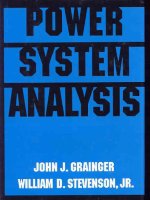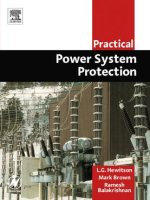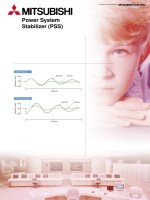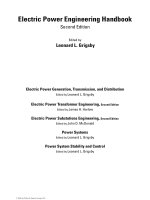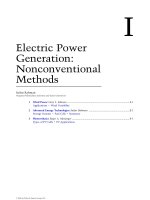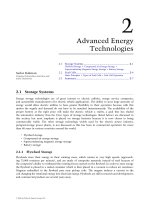Power System Components
Bạn đang xem bản rút gọn của tài liệu. Xem và tải ngay bản đầy đủ của tài liệu tại đây (2.45 MB, 50 trang )
EE 742
Power System Components
Y. Baghzouz
ECE Department
UNLV
Desire to have a system with high reliability
and power quality
• High reliability ensured by
•
•
•
•
High quality of components
High level of system security
Reserve of generation
Interconnection with large systems
• High power quality ensured by
• Well regulated voltage levels
• Well regulated frequency
• Minimal waveform distortion (low harmonics)
Structure of a Power System
• Voltage levels:
–
–
–
–
–
Generation: 12-25 kV
Transmission: above 138 kV
Sub-transmission: 69-138 kV
Distribution: 4.16-69 kV
Utilization: below 4.16 kV
US Power Generation Mix
Transmission, Sub-transmission and Distribution
• Common transmission voltages: 138kV,
245kV, 345kV, 500kV, 765kV
• Common sub-transmission voltages: 69kV
• Common distribution voltages: 34.5kV, 25kV,
13.8kV, 13.2kV, 12.47kV, 4.16k
• Transmission power loss: ≈ 0.5%-1.5%
• Distribution power loss: ≈ 4%-6%
North American Power Grid
•
•
•
•
•
•
Utilities learned the benefits in reliability and reduced operating
reserves by connecting to neighboring systems.
There are over 3,000 electric utilities in the US.
Some provide service in multiple states.
Over 1,700 non-utility power producers.
Utilities are either investor-owned, publicly-owned, and Federal utilities.
Electric utilities are regulated by local, State, and Federal authorities.
Electric Utilities in Nevada
90% of the state’s electric load is served by NV Energy
10% of the load is served by 15 small rural electric utilities
/>
North American Interconnections
•
•
•
•
•
The power system of North America is divided into four major
Interconnections which can be thought of as independent islands.
Western – Generally everything west of the Rockies.
Texas - Also known as Electric Reliability Council of Texas (ERCOT).
Eastern – Generally everything east of the Rockies except Texas and Quebec.
Quebec.
North American Balancing Authorities
•
The actual operation of the Interconnections is handled by over 100
Balancing Authorities (BA’s). The BA’s dispatch generators in order to meet
their individual needs. Some BA’s also control load to maintain balance.
1000
0
Hour of Day
Time (mm/dd/yy)
9/28/2008
9/21/2008
9/14/2008
9/7/2008
8/31/2008
8/24/2008
8/17/2008
8/10/2008
8/3/2008
7/27/2008
7/20/2008
7/13/2008
7/6/2008
6/29/2008
3000
6/22/2008
4000
6/8/2008
6/1/2008
5000
System demand (MW)
6000
6/15/2008
1
2
3
4
5
6
7
8
9
10
11
12
13
14
15
16
17
18
19
20
21
22
23
24
System Load (MW)
Demand
• Changes in demand of individual customers is fast and frequent
• The aggregated demand is smoother, and total load fluctuations
are usually small.
6000
5000
4000
3000
2000
2000
1000
0
Generation-load balance
• As electricity itself cannot presently be stored on a large scale, changes in
customer demand throughout the day and over the seasons are met by
controlling conventional generation, using stored fuels.
• Frequency is maintained as long as there is a balance between resources
and customer demand (plus losses). An imbalance causes a frequency
deviation.
• The overall daily profile of load in a given area can be predicted reasonably
well using forecasting tools.
• A day-ahead generating schedule can be developed based on the
predicted next-day load profile.
Frequency: the heartbeat of a power System
– The figure below shows a sample time history of the frequency on the
grid in the western United States, sampled six times a second. The slope of
the frequency trace is a measure of the overall imbalance of generation
and load at any given moment.
– The actual grid frequency tends to oscillate slightly around 60 Hz. The
frequency error from 60 Hz is used to fine-tune the generation level
through regulation.
Source: Alec Brooks, Ed Lu,Dan Reicher, Charles Spirakis, and Bill Weihl,”Demand Dispatch” IEEE Power &
Energy magazine, May/June 2010
Optimal generator scheduling & Dispatching
Given a power system with n generators, and a load forecast, the problem is
to determine the optimal schedule of each generator while recognizing
generating unit limits and output capability.
6000
5000
4000
3000
2000
Base Load
1000
0
1
2
3
4
5
6
7
8
9
10
11
12
13
14
15
16
17
18
19
20
21
22
23
24
System Load (MW)
•
Hour of Day
Unit # x
Unit # y
Unit # z
Generation fleet characteristics
• Each generating unit has specific (fixed) physical characteristics
that determine the capability of each unit to respond to changes
in system load in the up or down direction:
–
–
–
–
–
–
–
Minimum generation – Pmin (MW)
Maximum generation – Pmax (MW)
Maximum ramp rate – R (MW/min)
Scheduled operating point - Psched (MW)
Regulation reserve (MW)
Load following reserve (MW)
Contingency reserve – Pcont (MW)
Reserve allocation in scheduling process
Operating Reserve Requirements
• BA’s are required to maintain the following types of reserves
(typically 10-15% of peak load) to provide for regulation, balance
against the load forecasting error and to maintain local area
reliability:
• Spinning Reserve – Unloaded generation that is synchronized,
automatically responsive to frequency deviations (AGC), and
ready to serve an additional demand.
• Non-Spinning Reserve – (1) The generating reserve, which is not
connected to the system but capable of serving the demand
within a specified time from its activation; and (2) loads that can
be removed from the system within a specified time.
Interchange error
• Customer demand and generation are constantly changing
within all BA’s.
• → BA’s will have some unintentional outflow or inflow at any
given instant.
• A Balancing Authority’s internal obligations is to control an
instantaneous value called the Area Control Error (ACE) by
keeping it within acceptable limit that is proportional to the BA
size (44 MW for NV Energy South?).
• Conceptually, the ACE informs the Balancing Authority what the
frequency is doing in the Interconnected system. For example,
over-generation makes ACE go positive and puts upward
pressure on Interconnection frequency.
Tie-line
M
Scheduled net flow: 350 MW
Actual net flow: 340 MW
(due to load reduction)
ACE goes positive
Frequency goes up
Reduce generation
Power system operation – Real time
• In real time, the level of generation is adjusted to meet differences
between actual loads and the hourly schedules. This real-time
adjustment, can be separated into “load following” (within-hour
resource dispatching) and “regulation” (sub-minute adjustments of
generation) processes according to their respective time scales.
• Load following typically requires adjustments every 10
minutes. This is accomplished through a re-dispatch of on-line
generation via automatic adjustments by computerized
control systems.
• Regulation is effected by making sub-minute output
adjustments exclusively through an automatic generation
control (AGC) system.
• During real time operation, generators under AGC are adjusted every
2 or 4 seconds (although their actual responses are slower) to keep
the ACE close to zero.
Illustration of Regulation and Load Following
• Load following is the difference between 10-minute interval average
and 60-minute average (both with ramps) of load, depicting the
variation of load within the hour at a 10-minute time scale.
– Load Following = [real-time schedule] – [hourly schedule]
– Regulation = [actual load] – [ real-time schedule]
• Note that the regulation ramps (i.e. slopes) are significantly higher
than those of load following
Assessing Adequacy of Ramping Capability
• Insufficient ramping capability is identified when the ramp
requirements exceed generation fleet ramping limits.
• The figure below illustrates how such a deficiency could occur: the area
in red highlights the magnitude and duration of the interval when
regulation ramp requirements exceed fleet capability.
• More units and capacity are needed if composite unit ramping
capability is insufficient,
Power Generation Unit (hydro/steam/gas)
Rotating and Static Excitation Systems
• Power rating: typically less than 1% of
generator rating.
• Voltage rating: less than 1 kV
Block diagram of excitation and AVR system
• The AVR regulates generator voltage by controlling
the amount of field current.
• Regulation is stabilized using feedback loops.
• Limiters are used to protect the system from
excessive currents and voltages.
• The PSS helps with the damping of power swings
in the system.

